《固体物理学》课程教学课件(PPT讲稿)Chapter 5 band theory 5.5 The symmetry of bands

5.5 The symmetry of bands The symmetry of crystal leads to the symmetry of electron motion.So,the eigenenergy and states also possess symmetry which describe the electron motion status.The understanding of the symmetry is favorable to the simplification of problems.For example,when we are calculating or draw the diagram of bands in the k space,we can fully exploit the band symmetry
5.5 The symmetry of bands The symmetry of crystal leads to the symmetry of electron motion. So, the eigenenergy and states also possess symmetry which describe the electron motion status. The understanding of the symmetry is favorable to the simplification of problems. For example, when we are calculating or draw the diagram of bands in the k space, we can fully exploit the band symmetry

The symmetry of E(k)function 5.5.1 E(k)=E(k+Gp) Translation symmetry If reduced wave vector k is changed by a reciprocal vector,the phase change indeed is the same,eg,k is equal to k+GSo,we can regard that E(k)is the periodic function in the k space,whose periodicity is the reciprocal vector.The values scope of the k is the Wigner-Seitz cell in the reciprocal lattice space,eg,the FBZ Based on the translation symmetry,we can translate the parts of the second Brillouin zone into the FBZ by a reciprocal vector. Similarly,More terms of Brillouin zone can also be superposed with the FBZ by the appropriate translation.Noteworthily,the above expression could only be correct in the same band
If reduced wave vector k is changed by a reciprocal vector, the phase change indeed is the same, eg, k is equal to k+Gh . So, we can regard that En (k) is the periodic function in the k space, whose periodicity is the reciprocal vector. The values scope of the k is the Wigner-Seitz cell in the reciprocal lattice space, eg, the FBZ. Based on the translation symmetry, we can translate the parts of the second Brillouin zone into the FBZ by a reciprocal vector. Similarly, More terms of Brillouin zone can also be superposed with the FBZ by the appropriate translation. Noteworthily, the above expression could only be correct in the same band. The symmetry of En (k) function ( ) ( ) n n Gh E k E k 5.5.1 = + Translation symmetry

☐FBZ □ 2ndBZ■3rdBZ The first three Brillouin Zones for the 2D tetragonal lattice
The first three Brillouin Zones for the 2D tetragonal lattice
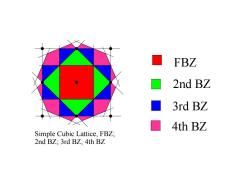
FBZ 2nd BZ 3rd BZ 4th BZ Simple Cubic Lattice,FBZ; 2nd BZ:3rd BZ:4th BZ
Simple Cubic Lattice, FBZ; 2nd BZ; 3rd BZ; 4th BZ FBZ 2nd BZ 3rd BZ 4th BZ

5.5.2 En(k)=En(ak) Point group symmetry the bands have the same symmetry with the lattice,where a is an any point symmetry operator Based on the Schrodinger equation HVn()=E,(kwnk() For the fact that the point group of crystal is kept unchanged after the point operator,so after the operation of a,the wavefunction is changed as (F)=Wnk(ar) Which should be a eigenfunction with the same eigenvalue V(+aR)=eark(cF The dot product is supposed to be the same after the point operation
E (k ) E ( k ) n n = the bands have the same symmetry with the lattice, where is an any point symmetry operator 5.5.2 Point group symmetry ( ) ( ) ( ) ˆ H r E k r nk n nk = Based on the Schrodinger equation Which should be a eigenfunction with the same eigenvalue For the fact that the point group of crystal is kept unchanged after the point operator, so after the operation of , the wavefunction is changed as (r) ( r) n nk = ( r R ) e ( r) nk ik R nk n n + = The dot product is supposed to be the same after the point operation
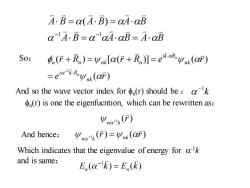
AB=a(A·B)=oA·aB a1A.B=aaA·B=AB S0: ,(F+反)=以nk[a(F+n】=e成ynt(ar) =a(ci)) And so the wave vector index for (r)should be :a (r)is one the eigenfucntion,which can be rewritten as: Wna(F) And hence: Vna(F)=Vnk(ar) Which indicates that the eigenvalue of energy for ak and is same: E(ak)=E,(k)
A B A B A B A B A B A B = = = = −1 −1 ( ) So: ( ) ( ) [ ( )] ( ) 1 e r r R r R e r n k i k R n k ik R n n n k n n n − = + = + = And so the wave vector index for n (r) should be : k −1 n (r) is one the eigenfucntion, which can be rewritten as: 1 (r) n k − And hence: 1 (r) ( r) nk n k − = Which indicates that the eigenvalue of energy for -1k and is same: ( ) ( ) 1 E k E k n n = −
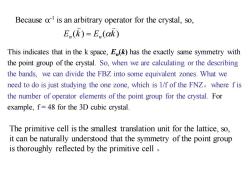
Because a is an arbitrary operator for the crystal,so, E,(k)=E,(ak) This indicates that in the k space,E(k)has the exactly same symmetry with the point group of the crystal.So,when we are calculating or the describing the bands,we can divide the FBZ into some equivalent zones.What we need to do is just studying the one zone,which is 1/f of the FNZ,where fis the number of operator elements of the point group for the crystal.For example,f=48 for the 3D cubic crystal. The primitive cell is the smallest translation unit for the lattice,so, it can be naturally understood that the symmetry of the point group is thoroughly reflected by the primitive cell
E (k ) E ( k ) n n = Because -1 is an arbitrary operator for the crystal, so, This indicates that in the k space, En (k) has the exactly same symmetry with the point group of the crystal. So, when we are calculating or the describing the bands, we can divide the FBZ into some equivalent zones. What we need to do is just studying the one zone, which is 1/f of the FNZ,where f is the number of operator elements of the point group for the crystal. For example, f = 48 for the 3D cubic crystal. The primitive cell is the smallest translation unit for the lattice, so, it can be naturally understood that the symmetry of the point group is thoroughly reflected by the primitive cell
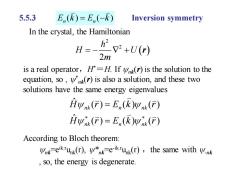
5.5.3 E,(k)=E (-k) Inversion symmetry In the crystal,the Hamiltonian H=- v2+U() 2m is a real operator,H=H.If k(r)is the solution to the equation,so,(r)is also a solution,and these two solutions have the same energy eigenvalues HVn(F)=E(k)vnk() HWk()=E(k)wnk() According to Bloch theorem: kru(),ikr(r,the same with so,the energy is degenerate
In the crystal, the Hamiltonian ( ) 2 2 2 H U m = − + r is a real operator,H* =H. If nk (r) is the solution to the equation, so , * nk (r) is also a solution, and these two solutions have the same energy eigenvalues 5.5.3 E (k ) E ( k ) n n = − ( ) ( ) ( ) ˆ ( ) ( ) ( ) ˆ H r E k r H r E k r nk n nk nk n nk = = Inversion symmetry According to Bloch theorem: nk=eik.runk(r), * nk=e-ik.runk(r) ,the same with -nk , so, the energy is degenerate

w4(下+R)=etw(F) W-k(F+R)=e(F) E(k)=E(-k) The result is independent of the symmetry of point group. Whatever is there a symmetry centre,in the space ofk,there is inversion symmetry for E,(k),which indeed result from the time inversion symmetry The followings are the schematic description of the band structures
( ) ( ) ( ) ( ) r R e r r R e r n k ik R n k n n k ik R n k n n n − − − − + = + = E (k ) E ( k ) n n = − The result is independent of the symmetry of point group. Whatever is there a symmetry centre, in the space of k, there is inversion symmetry for En (k), which indeed result from the time inversion symmetry . The followings are the schematic description of the band structures
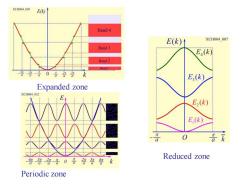
XCH004005 E(k) Band 4 E(K)↑ XCH004007 Band 3 E4(k) Band 2 吾吾-吾0吾吾0k E,(k) Expanded zone XCH004032 E,(k) E,(k) π a Reduced zone -“西-吾晋0晋吾经誓k Periodic zone
Expanded zone Reduced zone Periodic zone
按次数下载不扣除下载券;
注册用户24小时内重复下载只扣除一次;
顺序:VIP每日次数-->可用次数-->下载券;
- 《固体物理学》课程教学课件(PPT讲稿)Chapter 4 lattice dynamics and lattice capacity 4(supplement - Thermal Expansion of Glass).ppt
- 《固体物理学》课程教学课件(PPT讲稿)Chapter 4 lattice dynamics and lattice capacity 4.6 Anharmonic Effects 4.7 Equation of states for Lattice 4.8 Experimental methods for the determinations of lattice vibration spectroscopy.ppt
- 《固体物理学》课程教学课件(PPT讲稿)Chapter 5 band theory 5.1 general background and approximations 5.2 Bloch’s Theorem.ppt
- 《固体物理学》课程教学课件(PPT讲稿)Chapter 4 lattice dynamics and lattice capacity 4.5 Heat capacity of the lattice.ppt
- 《固体物理学》课程教学课件(PPT讲稿)Chapter 4 lattice dynamics and lattice capacity 4.1 Normal Modes of Vibration 4.2 Density of States 4.3 Harmonic approximation and normal mode coordinates 4.4 phonon.ppt
- 《固体物理学》课程教学课件(PPT讲稿)Chapter 3 Interatomic Bonding 3.1 General crystal binding 3.2 typical binding.ppt
- 《固体物理学》课程教学课件(PPT讲稿)Chapter 3 Interatomic Bonding 3(Supplement - Rules of crystal binding).ppt
- 《固体物理学》课程教学课件(PPT讲稿)Chapter 3 Interatomic Bonding 3.3 The cohesive energy for ionic crystal.ppt
- 《固体物理学》课程教学课件(PPT讲稿)Chapter 2 Wave Diffraction & the Reciprocal Lattice(2.1-2.5).ppt
- 《固体物理学》课程教学课件(PPT讲稿)Chapter 2 Wave Diffraction & the Reciprocal Lattice 2.6 X-Ray Diffraction Methods 2.7 Applications of XRD.ppt
- 《固体物理学》课程教学课件(PPT讲稿)Chapter 2 Wave Diffraction & the Reciprocal Lattice(supplement - Review & Overview of X-Rays).ppt
- 《固体物理学》课程教学课件(PPT讲稿)Chapter 1 Crystal Structure 1.9 Elements of Symmetry 1.10 Space groups 1.11 7 crystal system and 14 Bravis Lattice.ppt
- 《固体物理学》课程教学课件(PPT讲稿)Chapter 1 Crystal Structure(Supplement - microstructure and crystal system).ppt
- 《固体物理学》课程教学课件(PPT讲稿)Introduction.ppt
- 《固体物理学》课程教学课件(PPT讲稿)Chapter 1 Crystal Structure 1.1 Elementary Crystallography 1.2 Crystal Structure ≡ Lattice + Basis 1.3 Lattice Translation Vectors 1.4 Non-Bravais Lattices 1.5 Wigner-Seitz Method.ppt
- 《固体物理学》课程教学课件(PPT讲稿)Chapter 1 Crystal Structure 1.6 typical crystal structure.ppt
- 《固体物理学》课程教学课件(PPT讲稿)Chapter 1 Crystal Structure 1.7 Lattice Sites in a Cubic Unit Cell 1.8 crystal plane and miller index.ppt
- 《固体物理学》课程教学资源(参考资料)词汇汉英对照.pdf
- 《固体物理学》课程授课教案(讲义)第五章 能带理论.pdf
- 《固体物理学》课程授课教案(讲义)第一章 晶体结构.pdf
- 《固体物理学》课程教学课件(PPT讲稿)Chapter 5 band theory 5.3 Nearly Free Electron 5.4 BZ and energy bands.ppt
- 《固体物理学》课程教学课件(PPT讲稿)Chapter 5 band theory 5.4 Tight Binding Approximation(TBA).ppt
- 《固体物理学》课程教学课件(PPT讲稿)Chapter 6 Electron motion in the crystal 6.1 The quasi-classical description of Bloch electrons 6.2. Electron quasi-momentum 6.3 The accelerated velocity and effective mass.ppt
- 《固体物理学》课程教学课件(PPT讲稿)Chapter 6 Electron motion in the crystal 6(supplement - a more concise description of quasi-momentum).ppt
- 《固体物理学》课程教学课件(PPT讲稿)Chapter 6 Electron motion in the crystal 6.4 The electron motion in a constant electric field 6.5 Band structure of conductor, insulator and semiconductor.ppt
- 《固体物理学》课程教学课件(PPT讲稿)Chapter 7 The electronic theory of metal(supplement - Sommerfield expansion).ppt
- 《固体物理学》课程教学课件(PPT讲稿)Chapter 7 The electronic theory of metal 7.1 Fermi statistics and the heat capacity of electron 7.2 Work function and contact potential.ppt
- 《固体物理学》课程教学课件(PPT讲稿)Chapter 5 band theory 5.6 Density of states(DOS)and Fermi surface 5.7 the electrons in the crystal 5.8 the experimental results for DOS.ppt
- 《近代物理实验》课程教学大纲.doc
- 《近代物理实验》课程教学资源(PPT课件讲稿,共五部分).ppt
- 《工程光学》课程教学大纲 Engineering Optics.doc
- 安徽大学:《工程光学》课程授课教案(讲义,共十三章,授课教师:李桂华).doc
- 《工程光学》课程实验指导书(共六个实验).doc
- 《量子力学》课程教学课件(讲稿)Chapter 4 态和力学量的表象 The representation for the states and dynamical variable.pdf
- 《量子力学》课程教学课件(讲稿)Chapter 1 绪论 Quantum mechanism(量子力学的诞生).pdf
- 《量子力学》课程教学课件(讲稿)Chapter 2 波函数和薛定谔方程 The wave function and Schrödinger Equation.pdf
- 《量子力学》课程教学课件(讲稿)Chapter 3 量子力学中的力学量 The Dynamical variable in Quantum Mechanism.pdf
- 《量子力学》课程教学课件(讲稿)Chapter 6 散射 Scattering.pdf
- 《量子力学》课程教学课件(讲稿)Chapter 5 微扰理论近似方法 Approximation(本征值问题的似解).pdf
- 《量子力学》课程教学课件(讲稿)Chapter 7 自旋与角动量、全同粒子体系 Spin and undistinguished similar particles.pdf
